| 7 | How Radio Works |
Any study of the marketing of recordings must include an understanding of traditional radio and the role it plays in reaching target markets for the music. How important is radio? Veterans of the recording industry estimate that as many as 70% of consumer decisions to purchase CDs can be traced directly back to exposure to the music via radio. As much as consumers complain about the large number of commercials and repeated playing of the same records, radio still is the most important vehicle the recording industry has to showcase its product to the public.
Edison Media Research tells us that Americans spend an average of two hours each day—weekdays and weekends alike—in a vehicle on the road, either as a driver or a passenger. And despite cell phones, tapes, CDs, MP3 players, GPS units, video playback units and other distractions, we still spend a third of our time listening to radio while we are in a vehicle (Edison Research, 2004).
Given the role radio plays in promoting recordings to consumers, it’s important to have an understanding of radio and the people who make programming decisions at those stations.
One of the best adjectives to describe the relationship shared by the recording industry and radio is “symbiotic.” Though it’s a term most often used in science, it means the two industries share a mutual dependence on each other for a mutual benefit. Radio depends on the recording industry to provide elements of its entertainment programming for its listeners, and the recording industry depends on radio to expose its product to consumers. No two other industries share a relationship as unique as this. However, the nature of the businesses of a record company and a radio station are very different. For a record company, it’s easy to define the business: to sell recordings. Money moves from consumers to a record company when recordings are sold.
The business of radio is building an audience that it leases to advertisers. Radio uses music to attract listeners in order to attract advertising revenue. The larger the audience the station attracts, the more it can charge for its advertising. Notice that radio is not in the business of building recording careers, nor is it interested in selling recordings. The number of units that a recording is selling might be of interest to a radio programmer, but that information does not necessarily affect programming decisions.
The radio broadcasting industry
The traditional over-the-air radio broadcast industry in the United States has been consolidating since the Telecommunications Act of 1996 was signed into law. Prior to the new law, radio broadcasting companies were limited in ownership to fewer than 20 stations. The law now allows companies very broad latitude on the number of radio stations they may own, but it typically limits the control of a radio audience to less than 30% for most markets.
This new age of radio ownership has created some of the largest media companies ever. Among them are:
Table 7.1 Radio station groups

Earnings for the industry have been growing, but slowly. In 2003, revenues for the radio broadcasting industry were $19,705,000,000, or up 1% from the prior year. With an anticipated 6% growth in 2004, the industry was expected to earn about $21 billion when the report was completed (Grillo, J.B., 2004).
Comparing radio with the recording industry, the RIAA reports shipments of recordings at retail price for 2003 were $11,854,000,000. The actual value of sales after discounts from MSRP was less. Generally, for comparative purposes, the radio industry in our country is nearly twice the size of the recording industry. The FCC licenses stations based upon the available frequencies, and because there has been no growth in frequencies allotted by the commission, the number of stations has remained fairly static. In 2004 in the United States, the FCC reported there were 4,770 AM stations, 6,217 FM commercial stations, and 2,512 FM educational stations for a total of 13,499 (FCC Report, 2004).
The radio station staffing

![]() Figure 7.1 Typical radio station
Figure 7.1 Typical radio station
In order to see how decisions are made about music choices at a radio station, it is important to understand the relationships within the station. The general manager, or someone with a similar title, is responsible for the business success of the station. Reporting to the general manager is a manager of administration who has responsibilities such as accounting, commercial scheduling, and keeping up with regulatory matters. The sales manager has a staff of people who sell available commercial time to advertisers. Promotions are contests and other sales-oriented activities that are often the collaborative work of the sales team as well as the programming department.
From a record marketing standpoint, the key positions at a radio station are the program director, and to a lesser degree, the music director. The program director (PD) is genuinely the gatekeeper. Without the “okay” of the programmer, there is no chance that a recording will get on the air at most large radio stations. The PD is directly responsible to the general manager for creating programming that will satisfy the target market and build the existing audience base. The programmer decides what music is played, which announcers are hired, which network services to use, how commercials are produced, and every other aspect of the image the station has within the community it serves.
Critics of radio often say program directors have too much power because they can decide whether a recording is ever exposed to listeners. Large radio chains have group programmers who play an even larger role as a gatekeeper, recommending which music is appropriate for similarly programmed stations owned by the company across the country.
Others say that radio is serving as a filter for the massive amount of recorded music that is created every year. Theoretically, radio finds the most appropriate music for its audience and filters the music by choosing the best selections for the target audience.
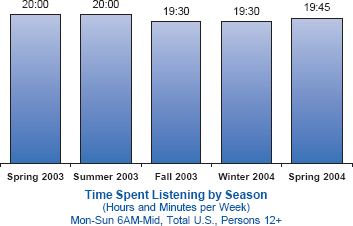
![]() Figure 7.2 Time spent listening by season (Source: Arbitron Radio Today 2005)
Figure 7.2 Time spent listening by season (Source: Arbitron Radio Today 2005)
According to Arbitron in 2004, more than 94% of the U.S. population over 12 years of age listens to radio each week (Arbitron Report, 2005). Americans spend about 20 hours per week listening to their favorite stations. This has remained relatively steady despite the growing number of consumer entertainment options. Time spent listening is greatest for males 25–64 and lowest for teens, at less than 12 hours per week for males and 15 hours per week for females. Females spend less time than males across all age categories except 65+.
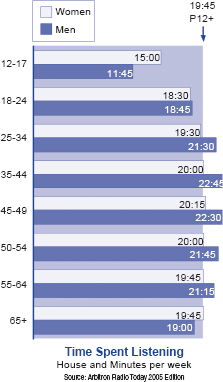
![]() Figure 7.3 Time spent listening by age group (Source: Arbitron Radio Today 2005)
Figure 7.3 Time spent listening by age group (Source: Arbitron Radio Today 2005)
Radio listening peaks in the morning hours, known as morning drive time. Radio listening is divided into dayparts of morning drive, midday, afternoon drive, evening, and overnight. From 6:00 a.m. until 9:00 a.m., listening is greatest as commuters wake-up to clock radios, and they continue to listen as they drive to work. Listening picks up again around noon, declines slightly after lunch but remains relatively strong through the afternoon drive time, and then tapers off drastically throughout the evening and into the overnight period.

![]() Figure 7.4 Hour-by-hour listening (Source: Arbitron Radio Today 2005)
Figure 7.4 Hour-by-hour listening (Source: Arbitron Radio Today 2005)
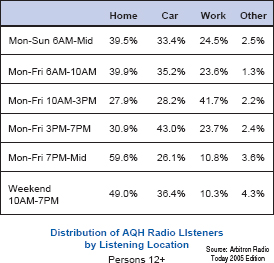
![]() Figure 7.5 Distribution of AQH radio listeners (Source: Arbitron Radio Today 2005)
Figure 7.5 Distribution of AQH radio listeners (Source: Arbitron Radio Today 2005)
Radio listening is very popular away from home. Between 8:00 a.m. and 6:00 p.m. on weekdays, a majority of radio listening occurs outside the home, as much as 72% of all listening. After 6:00 p.m., the majority of listening shifts to in-home. Much of the transient listening occurs either in vehicles or at work. During morning drive time, nearly 40% of listening occurs in the home, with another 36% occurring in vehicles and 23.4% at work. During midday, almost 42% of listening is at work. During afternoon drive time, 23% of listening occurs at work, with 43.7% occurring in vehicles and less than 31% at home. After 7:00 p.m., almost 60% of listening occurs at home. Across all age groups, men are more likely than women to listen outside the home.
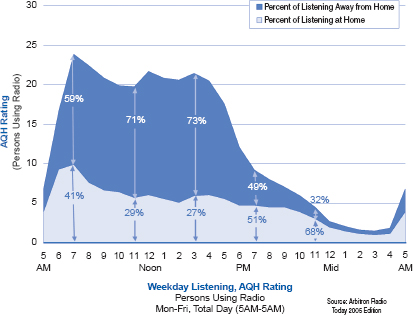
![]() Figure 7.6 Weekday listening, AQH rating (Source: Arbitron Radio Today 2005)
Figure 7.6 Weekday listening, AQH rating (Source: Arbitron Radio Today 2005)
Station owners choose radio formats by finding an underserved audience that is attractive to advertisers. When the format is chosen and developed, a programmer and staff are hired, and the audience develops. The chart shows how the national radio audience shares developed by format in 2004. The horizontal axis reflects the percentage of radio listeners who chose the formats represented in the chart.
The Arbitron audience measurement service reports the national percentages of radio format shares in the chart. The top radio format is news/talk. This format has grown in recent years and now represents about 16% of all listeners.
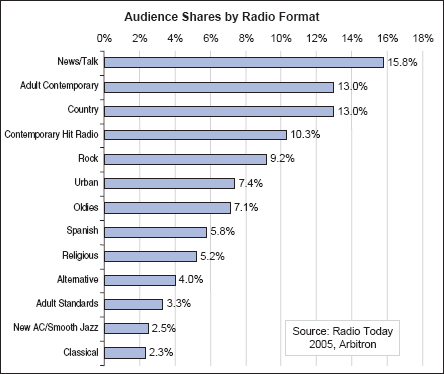
![]() Figure 7.7 Audience shares by radio format (Source: Arbitron Radio Today 2005)
Figure 7.7 Audience shares by radio format (Source: Arbitron Radio Today 2005)
The format shares shown in the chart have remained relatively the same over the years 1998–2004 with a few exceptions. Urban listenership has grown by 26%, and listeners to Spanish language formats have grown by 25%. Religious-formatted radio stations have seen a growth of 34% since September 11, 2001.
Arbitron is the only major company that measures the size and demographics of radio audiences. While the audience share chart shows the national audience share, Arbitron measures the same information, radio market by radio market. The share and audience makeup of each individual commercial radio station is measured and reported to subscribing stations and advertising agencies. The size of the station’s radio audience is directly related to the amount of money the station can charge for its advertising. The more listeners (or the larger its audience share), the more the station charges companies to access their audience through advertising. Arbitron charges its clients tens of thousands of dollars for its audience measurement services. Since college and other noncommercial stations do not use traditional advertising, their audience shares are not reported.
With this in mind, a programmer is very careful in choosing music for airplay since the objective is to build its target audience. The program director is not inclined to experiment with an unproven recording that will turn an audience off. More about this will be discussed in a later chapter.
In order to be a commercial product, recorded music must find a target that is able and willing to buy it. Finding that target is the first step in the marketing process followed by the development of a strategy to reach the target.
Table 7.2 Formats and target demographic
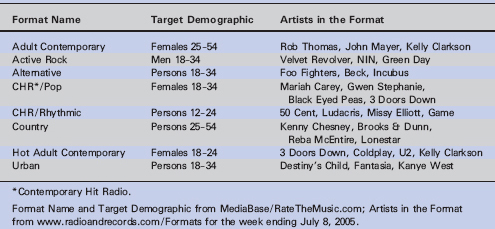
The target market of a particular radio format is the logical consumer target for commercial recordings. As of this writing, there are over 25 specific radio formats. In Table 7.2 on the preceding page are some broad definitions of music formats and their targets.
Radio station group owners often refine these gender and age targets. For example, some country radio stations owned by Clear Channel Communications specifically target females 35–44 for their country programming, while some owners target 12–24 males with the rap and hip-hop sounds of CHR/Rhythmic. The ability to obtain airplay can be a major factor in determining which records get made.
One of the key components of most of these radio market targets is the 18–34 year-old female. Women in this age group heavily influence or actually make the purchase decisions for households, and advertisers highly value this demographic as a target for their messages. Marketers of recorded music should continually consider this reality of radio as they plan to reach their own target market.
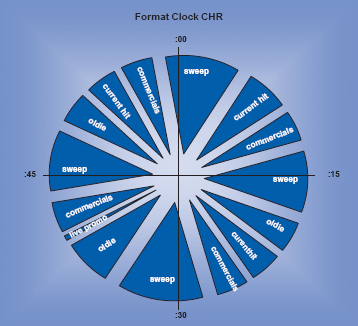
![]() Figure 7.8 Format clock
Figure 7.8 Format clock
Programmers sometimes use a clock wheel to offer a visualization of how time is allotted to the various broadcast elements. It is a wheel indicating sequence or order of programming ingredients aired during one hour (Tarver, C., 2005). The clock face is divided into pie pieces, and each small section of time in an hour is prescribed a very specific item to be played on the air—from a song in a specific genre to a commercial, or news and weather.
What is important to programmers
Convincing radio to play new music is “selling” in every sense of the word. And in order to sell someone anything, you must know what is important to them and what their needs are. High on that list of important things to radio is Arbitron’s measurement of radio audiences because it directly impacts the earnings of the station for its owners. Understanding concepts like this and their importance to programmers will help marketers of recorded music better relate to the needs of radio and its programming gatekeepers.
The term P–1 listeners represents one of the prized numbers of radio programming. As Mike McVay with McVay Media puts it, “These first preference listeners … are referred to in radio station boardrooms, focus groups, and inside the headquarters of Arbitron doing diary reviews.” McVay says the term P–1 describes “the most loyal of radio listeners,” and every radio programmer courts this primary core of their radio audiences (www.mcvaymedia.com). The terms P–2 and P–3 refer to listeners with a lesser degree of connection and loyalty to a particular radio station.
Cume is a programming term that comes from the word cumulative, and it refers to the total of all different listeners who tune into a particular radio station, measured by Arbitron in quarter-hour segments. In other words, it is the total number of unduplicated persons included in the audience of a station over a specified time period.
AQH, or average quarter-hour, refers to the number of people listening to a radio station for at least five minutes during a fifteen minute period.
TSL means “time spent listening” by radio station listeners at particular times of the day. TSL is calculated by the following formula.
![]()
A radio station’s share refers to the percentage of persons tuned to a station out of all the people using the medium at this time.
![]()
Rating refers to the percentage of persons tuned to a station out of the total market population.
![]()
A full review of terms used in audience measurement is available at www.arbitron.com.
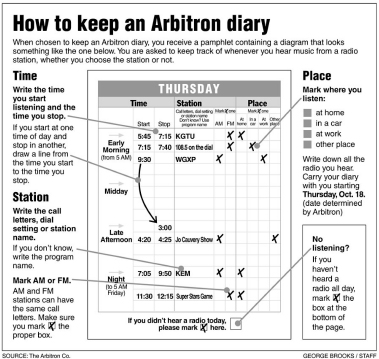
![]() Figure 7.9 How to keep an Arbitron diary (Source: Arbitron)
Figure 7.9 How to keep an Arbitron diary (Source: Arbitron)
Arbitron measures ratings in 280+ markets in the U.S. Ratings are measured using the diary method. Arbitron selects households at random, and asks members age 12 and above to carry a diary for one week and record their radio listening. Potential diary keepers are first contacted by telephone, and then diaries are sent to the household. Completed diaries are returned to Arbitron and the data are entered into computers and analyzed on the following characteristics:
![]() Geographic survey area (metro or total survey area)
Geographic survey area (metro or total survey area)
![]() Demographic group
Demographic group
![]() Daypart
Daypart
![]() Each station’s AQH: the estimated number of persons listening
Each station’s AQH: the estimated number of persons listening
![]() Each station’s rating: the percent of listeners in the area of study during the daypart
Each station’s rating: the percent of listeners in the area of study during the daypart
![]() Each station’s share: the percent of one station’s total daypart estimated listening audience
Each station’s share: the percent of one station’s total daypart estimated listening audience
![]() Cume: the total unduplicated audience during the daypart for an average week
Cume: the total unduplicated audience during the daypart for an average week
Each Arbitron Radio Market Report covers a 12-week period for the specified market and contains numerous pages like the example in Figure 7.10 on the following page. At the top of each page, the target demographic is listed. Beneath that, the dayparts are laid out in columns. Then for each daypart, the AQH, the Cume, the AQH rating and AQH share are listed for each radio station in the area (listed in the left-hand column).
Ratings as defined by the audience share of a station determine advertising rates, and the example of an Arbitron report of the Atlanta radio market makes the point that ratings mean money. The chart in Appendix A (p. 141) shows the call letters, the station format, the owner, and the percentage of listeners in the Atlanta market who choose each station. The table of ratings is shown beginning with the fall of 2003 as an indication of the trends of the ratings for each station in the Atlanta market. The column on the far right is the station rating for fall 2004. The station showing 9.7% of the market’s radio audience charges more for advertising than the station with only 0.4% of the audience because it has more listeners, and can therefore charge more for its advertising. Arbitron rating points are the targets of the audience-building efforts of a radio programmer. For example, each one-tenth of a rating point, or 0.1%, is worth $1 million in advertising rates to radio stations in the Los Angeles radio market.
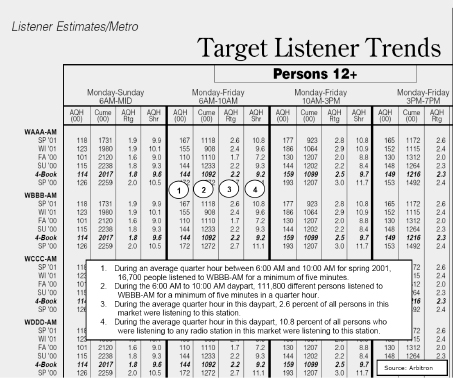
![]() Figure 7.10 Example Arbitron book (Source: Arbitron)
Figure 7.10 Example Arbitron book (Source: Arbitron)
Knowing how radio researches its audience can be helpful to marketers to understand how programmers define benchmarks for their decisions to add or remove music from their playlists, or increase or decrease the frequency songs are played. A pioneer in the area of radio audience research is Ed Salamon, who has a career in radio programming and is also an adjunct faculty member at MTSU. Mr. Salamon provided the following information about audience research.
In the early 1970s, Salamon was at KDKA radio in Pittsburgh and became one of the first radio programmers to research the music preferences of his audience. He began by adding programming questions to a local call out consumer survey, Marketing Information Bank (MIB), that Westinghouse Broadcasting did in each of their radio markets. By 1973, he had found other programmers including Bob Pittman, (at WDRQ, Detroit), Todd Wallace and John Sebastian (both at KRIZ Phoenix) who had likewise been independently applying research models to radio programming. Their sharing of information resulted in the system of music research that is still in use today.
When asked to explain music research as it is being done by radio today, Salamon provided the following:
With the demise of the single in favor of the album as the primary consumer unit, music tests became the only way for radio programmers to judge the popularity of an individual song because of the lack of sales information for a specific title.
In call out research, which is normally used to evaluate current music, respondents are played a short (ten to twenty second) portion of a song, called a “hook,” via telephone so that they can recognize it and respond. Approximately thirty titles at a time can be tested in this manner. Originally respondents were read the title and artist, but it was found that it is more accurate to play a portion of the actual recording. Importantly, new and unfamiliar music cannot be tested. A respondent normally needs to have heard a song about three times before it becomes familiar. Natural responses, such as “I don’t know it” or “it’s my favorite” are assigned numbers according to a semantic differential scale so that they can be tabulated.
Auditorium testing is generally used for noncurrent music, or library titles. It uses similar methodology as call out, but hundreds of titles can be tested in person versus by phone.
Later, some researchers began asking whether respondents would like to hear a song “more, less, or about the same” instead of open-ended responses. Recently, some music research has been done via the Internet. While many researchers believe that the self-selection of participants invalidates the results, others have adopted it because of lower costs and argue that the ability to play as much of a song as the respondent wants to hear allows new music to be tested for the first time.
He also points out that radio also uses focus group research not to test music, but to determine broad areas of format, personality, and image for the station, and to learn about its competitors. The radio industry has seen a shift away from focus groups recently, according to Edison Media Research (Webster, T., 2004). Instead, radio researchers have begun to include qualitative questions into quantitative projects. Tom Webster, vice president at Edison, warns that while focus groups do not produce answers, they ensure that the right questions are asked on quantitative surveys (see the chapter on research for more information on focus groups).
Radio also uses panels of listeners for programming research. The panel method is a research technique in which the same people are studied at different points in time. Members of the panel are selected to reflect a representative sample of a station or format’s listenership, and are periodically surveyed on their opinions of music and programming. The panel members are contacted either by phone or email and asked to respond to song hooks played either over the phone or through the Internet.
It is the job of the record promoter to get airplay on commercial radio stations. This has become more difficult with the consolidation of radio because there are fewer music programmers, and competition for getting added to the playlist is fierce. The process of record promotion is outlined in the following chapter on charts, airplay and promotion.
The new radio and new technology
Opportunities for marketers of recorded music are improving with the addition of new technology and new services to users of music.
Radio stations have been given approval to convert their signals from older analogue technology to digital signals. What this means to music marketers is that songs played on the radio will deliver near-CD quality audio, and have the ability to display the artist’s name and the song title on the radio receiver. Radio announcers infrequently provide artist or song information to listeners, and this new technology will help consumers of recorded music to identify artists and songs. Digital radio is expected to grow since the major broadcast companies have begun converting over 2,000 stations to digital broadcast signals, ultimately making them available to listeners in every major and large radio market. But because of the time and expense necessary for consumers to retrofit their radio receivers, it is unclear how quickly that diffusion into the marketplace will happen.
Major operators such as Clear Channel are acknowledging competitive pressures by continuously seeking new and untried delivery systems for their radio programming content. How traditional radio reacts to new media competitors will define its future.
Satellite radio is a new opportunity for music makers to get their products exposed to consumers. Two companies, XM Satellite Radio and Sirius Satellite Radio, are FCC-licensed services that allow subscribers with receivers to receive scores of custom-formatted radio channels. Sirius offers 100 commercial-free music and information channels (Yahoo company profile, 2005), which include the promise of Howard Stern’s radio show and every NFL football game. XM offers 150 channels (XM Satellite Radio, 2005), many of which are commercial-free, and their service includes every baseball game played in America. The opportunities for marketers of recordings with satellite services is that they have longer playlists within each genre of music, there are more opportunities for new music to be played, and every song played displays the artist and song title to the listener on the faceplate of the receiver. As a viable service, satellite radio has been slow to be adopted by consumers in part because of the cost of buying special receiving equipment for a vehicle or a home audio system, and because of the monthly fees associated with the services. But after just three and a half years in operation, the combined subscription numbers totaled over five million (Manley, L., 2005).
Internet “radio” is considerably different from radio in its traditional form. A number of browsers and Internet service providers include bundled software, which gives the user access to genre-specific music through their PC. While this is promoted as “radio,” it typically does not include the presence of an announcer or noncommercial information. There are, however, commercial terrestrial radio stations that have chosen to stream their off-the-air signal on the station’s home page and can often be found at the radio station call letters dot com. One advantage of Internet radio is that the song information is displayed on the computer screen as the song is played, often with a link to an online retail store to facilitate the impulse purchase.
Podcasting is a form of recorded Internet radio that allows users to download a pre-recorded radio program to their iPods, portable music player, or computer and listen at their convenience. A podcast is like an audio magazine subscription; a subscriber receives regular audio programs delivered via the Internet, and can listen to them at their leisure. Several celebrity DJs (such as Adam Curry, former VJ on MTV) are offering podcasting shows on their websites. The web-based encyclopedia Wikipedia describes podcasting as:
A podcast is like an audio magazine subscription: a subscriber receives regular audio programs delivered via the Internet, and can listen to them at their leisure. Podcasts differ from traditional Internet audio in two important ways. In the past, listeners have had to either tune in to web radio on a schedule, or they have had to search for and download individual files from webpages. Podcasts are much easier to get. They can be listened to at anytime because a copy is on the listener’s computer or portable music player (hence, the “pod” in “podcasting”), and they are automatically delivered to subscribers, so no active downloading is required (Wikipedia, 2005).
Podcasting and related technology offer consumers convenient ways to collect and organize new music for MP3 players without having to comb through personal collections and rip and burn individual songs.
One of the newest technologies in development is the Arbitron Portable People Meter system, with Houston and Philadelphia being its first test markets. According to Arbitron:
“The Portable People Meter (PPM) is a unique audience measurement system that tracks what consumers listen to on the radio, and what consumers watch on broadcast television, cable and satellite TV. The Portable People Meter is a pager-sized device that consumers wear throughout the day. It works by detecting identification codes that can be embedded in the audio portion of any transmission,” (http://www.aribtron.com, 2005).

![]() Figure 7.11 Arbitron’s Portable People Meter System (Source: Arbitron, arbitron.com)
Figure 7.11 Arbitron’s Portable People Meter System (Source: Arbitron, arbitron.com)
The meter is the size of a pager, and is worn at all times during the day. At night, the People Meter is placed into a base unit and information is uploaded to a central database. This technology will provide marketers of recorded music the opportunity to learn whether listeners tend to change stations when an artist or a song is played, or whether they tend to remain with a song when it is played. The People Meter could prove to be a key component in the development of pre-release and post-release marketing strategies for the recording industry. The People Meter is undergoing its field-testing in Philadelphia and Houston, but it will be several years before it is available on a nationwide basis (www.arbitron.com, 2005).
Add date – This is the day the label is asking that the record be added to the station’s playlist.
Average quarter-hour (AQH) – The number of people listening to a radio station during a fifteen minute period as measured by Arbitron is called the AQH.
Cume–The total of all different listeners who tune into a particular radio station is its cume.
Format – The kind of programming used by a radio station to entertain its audience is the format.
Heavy rotation – These recordings are among the most popular songs played on a radio station.
Light rotation – These are recordings that are played fewer times on a radio station than songs in heavy rotation.
Playlist– The list of songs currently being played by a radio station makes up a playlist.
P–1–The primary core of listeners to a specific radio station are P-1s.
Program director (PD) – This is an employee of a radio station or a group of radio stations who has authority over everything that goes over the air.
Share – A share is the radio audience of a specific station measured as a percentage of the total available audience in the market.
TSL – This means “time spent listening” by radio station listeners at particular times of the day.
References
Arbitron, and www.arbitron.com
Federal Communications Commission, http://www.fcc.gov/fcc-bin/audio/DOC-253919A1.doc
McVay, Mike, McVay Media, www.mcvaymedia.com
MidiaBase/Rate the Music (Clear Channel Entertainment)
Radio Advertising Bureau, and rab.org Radio and Records Magazine and rronline.com
Recording Industry Association of America
Radio Today: How America Listens to Radio (2005). Arbitron Report.
And special thanks to Tom Baldrica, BNA Records; Ed Salamon, Country Radio Broadcasters, Inc; R. J. Curtis, KZLA; Bill Mayne, 903 Music; Erica Farber, R&R Magazine; Bob Michaels, Arbitron; Lee Logan; Joe Redmond, Warner Bros. Records; Larry Pareigis, Sony BMG.
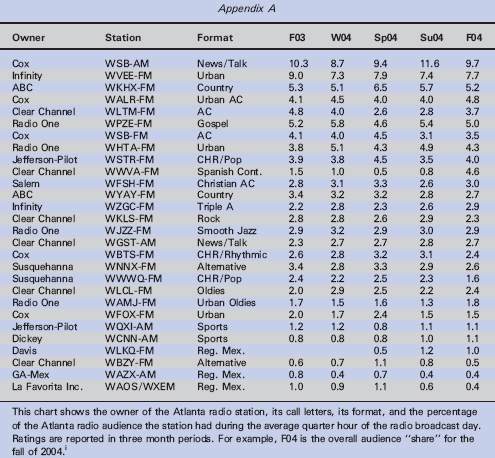
Arbitron Report (2005). How America Listens to Radio, Radio Today 2005 Report. http://www.arbitron.com/home/content.stm.
Edison Research (2004). www.Edisonresearch.com.
Grillo, J. B. (Feb 16, 2004). Radio Looks for March Upturn, Broadcasting and Cable, pp. 32. FCC Report (2004). www.fcc.gov.
Manley, L. (April 5, 2005). As Satellite Radio Takes Off, It Is Altering the Airwaves, New York Times, pp. 1.
Tarver, C. (2005). www.udel.edu/nero/Radio/glossary.html.
Webster, T. (2004). Edison Media Research: What’s Wrong with Focus Groups? http://www.edisonresearch.com/home/archives/000426print.html.
Wikipedia (2005). http://en.wikipedia.org/wiki/Podcasting.
www.arbitron.com(2005). http://www.arbitron.com/portable_people_meters/home.htm. Prior U.S. Market Trials.
www.aribtron.com (2005). http://www.arbitron.com/portable_people_meters/home.htm. The Portable People Meter System.
XM Satellite Radio (2005). http://www.xmsr.com/learn/programming.jsp.
Yahoo company profile (2005). http://finance.yahoo.com/q/pr?=SIRI.
______________________
i Arbitron, used by special permission.
